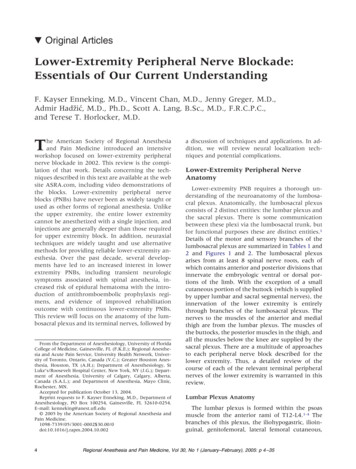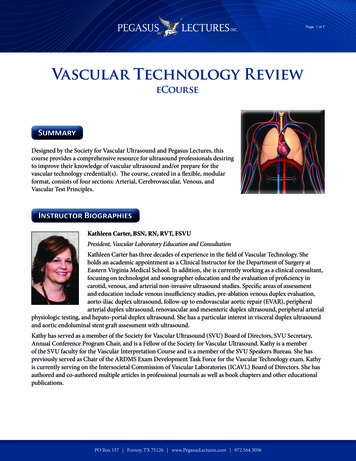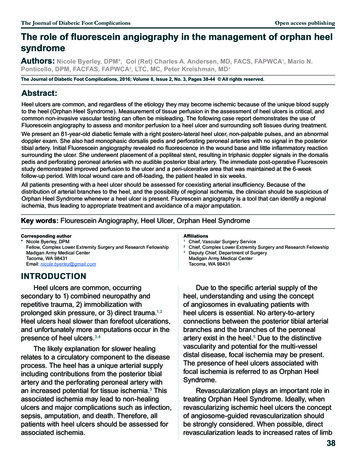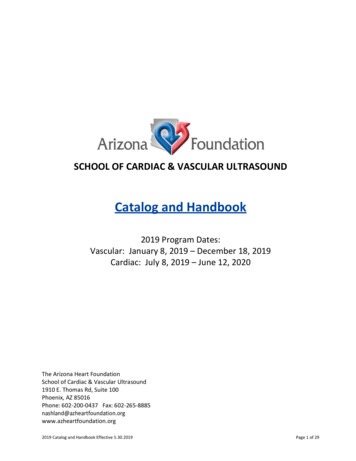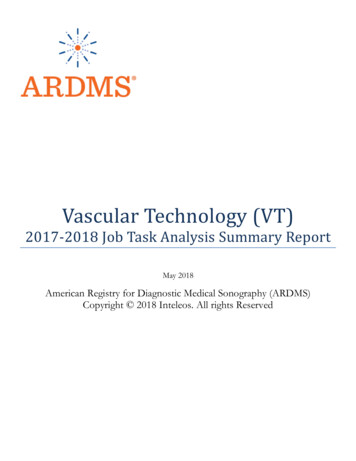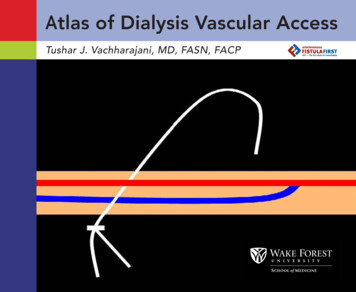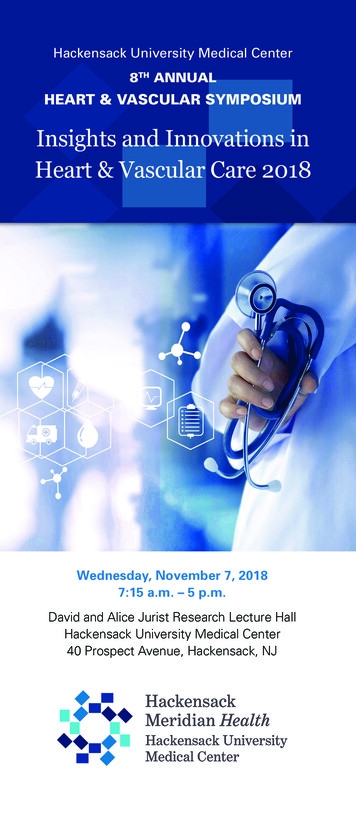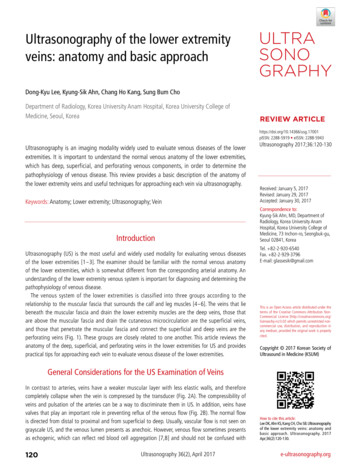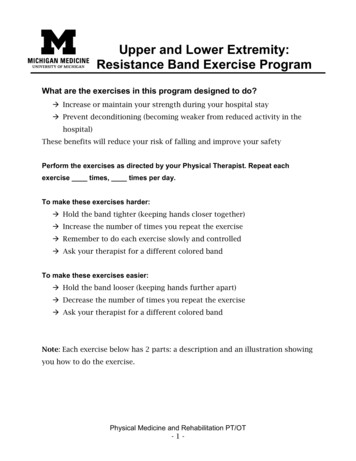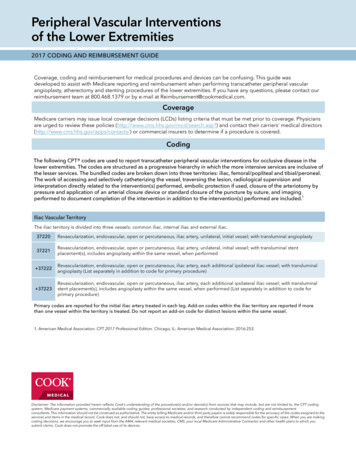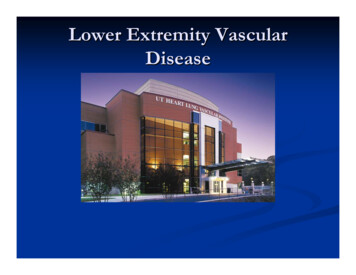
Transcription
Lower Extremity VascularDisease
Lower Extremity VascularDisease Popliteal arteryentrapmentMucinous cysticdegenerationBuerger's diseaseAbdominal aorticcoarctationEmboli FibrodysplasiaPseudoxanthomaelasticumPersistent sciatic arteryIliac artery syndrome ofcyclistPrimary arterial tumors
Atherosclerosis
Lower Extremity Vascular Disease Claudication Critical LimbIschemia
Claudication “Doc, my legs hurt.”Claudere - “to limp.”Transient, exerciseinduced ischemic myalgiaThe locality of painusually correlates withthe location of theocclusion.
Intermittent Claudication 13% of patients over 50 have abnormal ABI- Partner’s Program. Vasc Med 2001 ABI ranging from 0.5 to 0.95Relatively few patients who present withclaudication ever require revascularization toprevent limb loss.Amputation rate of 1% to 7% at 5 to 10 yearsRevascularizations totaled less than 20% at 10years.
Intermittent Claudication Intervention controversial 233 consecutive patients (90%endovascular)Mean follow-up of almost 7 yearsPrimary patency at 5 years was27%50% secondary interventions12% of limbs ultimately developedCLI Jamsen et al. J Vasc Surg 2003
Pros and Cons Benign natural historyGraft failure andpotential limb threatM&M ofrevascularization Diminished quality oflifeInability to rehab
Smoking 8% of patients who did not smoke or quitsmoking within 1 year of diagnosis of PADdeveloped rest pain21% who smoked or quit more than 1 year afterdiagnosisDiabetes also has been associated with increaseddevelopment of CLI
Critical Limb Ischemia Inadequate arterial bloodflow to accommodatethe metabolic needs ofresting tissue.Rest pain or pedalnecrosisRisk factors include age,smoking, and diabetes
Critical Limb Ischemia Ankle pressure less than 50 to 70 mmHg Toe pressure less than 30 to 50 mmHg Transcutaneous partial pressure ofoxygen at the foot less than 30 to 50mm Hg
Rest pain Burning dysesthesia ofthe foot.Aggravated by elevationand relieved withdependencyIncrease in arterialpressure from gravityNonfunctioningvenoarteriolar reflex
Tissue Loss Ischemic ulcerations organgreneSpontaneousAfter minor trauma orsurgical incisions
Critical Limb Ischemia Estimated 500,000 to 1 millionnew cases per yearCLI progresses directly fromFontaine I to stage III or IV50% of patients wereasymptomatic 6 months beforemajor amputation for CLI- Dormandy. Br J Surg 1994 Co-morbidities mask symptomsof claudication.
Critical Limb Ischemia Major risk factors - age,smoking, and diabetes.The incidence of majoramputation increases with age.Smoking:PAD Smoking:CADMajor amputation is 10 timesmore frequent in diabeticpatientsDiabetic smokers needamputation earlier in life thannondiabetic smokers
Evaluation
Relevant History Elapsed time after exercise is stopped before thepain is relievedType of rest or position of patient (standing atrest, sitting, lying) necessary to relieve the painWhether the pain returns after the same timeand distance if exercise is then resumedTASC Working Group: Management of peripheral arterial disease. J Vasc Surg 31(Pt 2):S56,2000
Relevant History Location of the pain or discomfortDuration of the symptomWhether it worsens or improves with time andwhether conservative therapy has had an effectDistance the patient can now walk before (1)experiencing the discomfort and (2) beingforced to stopTASC Working Group: Management of peripheral arterial disease. J Vasc Surg 31(Pt2):S56, 2000
Symptom Pattern Claudication generally results from a single levelof arterial occlusionThree major patterns of arterial obstruction1) Inflow obstruction2) Outflow obstruction3) CombinationLocation of symptoms correlates with level ofobstruction.
Inflow Obstruction Aortic and Iliac stenosis or occlusion.Buttock and thigh claudicationVasculogenic erectile dysfunctionMay exhibit classic symptoms of intermittentcalf claudication resulting from inadequateperfusion of the entire leg
Outflow Obstruction Superficial femoral arterystenosis or occlusion is the mostcommon lesion associated withintermittent claudicationNo specific thigh or footsymptoms.Popliteal and tibial arterialocclusions are associated morecommonly with limb-threateningischemia owing to the paucity ofcollateral vascular pathwaysbeyond these lesions.
Multilevel Obstruction Broad symptoms of intermittentclaudication affecting thebuttock, hip, thigh, and calf.CLI requires at least two or morelevelsPattern of occlusion is usually inadjacent vascular beds, but maybe in parallel bedsLimit flow through the collateralbeds
Risk Factor Assesment HTN – risk of IC 2.5x in men, 3.9x in womenDiabetesSmoking - severity of arterial occlusive diseaseproportional to the number of cigarettes smokedEach additional risk factor independentlyincreases the risk of developing symptomaticPAD
Risk FactorsDownloaded from: Vascular Surgery 6/e (on 20 April 2006 01:40 AM) 2005 Elsevier
Physical Exam Loss of hair Thin, dry skin Thickened nails Ulcers Edema Gangrene
Physical Exam
Pulses Bruits Pulsatile masses
Hematologic Evaluation Complete blood count, including white bloodcells and plateletsFasting blood glucoseSerum creatinineFasting lipid profileFibrinogen levelUrinalysisTASC Working Group: Management of peripheral arterial disease. J Vasc Surg 31(Pt 2):S59, 2000.
Hypercoaguable State Thrombin/prothrombin timeActivated partial thromboplastin timeProtein S/protein C assaysFactor V Leiden assayLupus anticoagulant assayHeparin-induced platelet antibodiesPlatelet adhesiveness/aggregabilityFibrinogen/plasminogen levelsAntithrombin activityAnticardiolipin antibody assay
Homocysteine Young patients with PAD,no other risk factorsToxic to endothelial cellsReduced ability to generateand release nitric oxide .Smooth muscle cellproliferationArterial wall inflammationIncreased levels ofplasminogen activatorinhibitor
Cardiac Evaluation
Cardiac Evaluation in CLI Assume that they all have significant CADPerioperative blood pressure control, antianginalregimens, and treatment for CHF are optimizedDelay intervention only for the presence offrequent or unstable angina, recent myocardialinfarction, poorly controlled CHF, orsymptomatic or untreated arrhythmia.Even in these instances, cardiac evaluationshould be focused and expeditious
Carotid Disease 225 patients, screened for carotidartery disease with dupleximagingHemodynamically significantstenoses in 28.4%4% had a greater than 80%stenosis requiring surgery12% with symptomatic lowerextremity had greater than 75%diameter reduction-Gentile et al. Arch Surg;1995- De Virgilio et al. AnnVasc Surg;1997
Assesment Is significant arterial occlusive disease present?If so, how severe is the physiologic impairment?Where are the responsible lesions located?In multilevel disease, which arterial segments aremost severely involved?
ABI’s and Segmental Pressures Segmental arterialpressure measurement,with the calculation ofthe ABIIdentifying the presenceof arterial occlusivedisease and locating thesegment involvedToe pressures useful indiabeticsShould include excercise
Pulse Volume Recordings Detect changes in thevolume of blood flowRapid systolic upstrokeand a rapid downstrokewith a prominent dicroticnotchWith increasing severityof PAD, the waveformsbecome more attenuatedwith a wide downslope
Screening B-mode ultrasound andpulsed wave dopplerNon-invasiveNo contrastHigh sensitivity andspecific for stenosis 50%Highly tech dependant
Evaluation Gadolinium-enhancedMRINo arterial puncture orstandard ionic contrastCan identify patent pedalvesselsClaustrophobiaArtifact
Evaluation CT angiographyEasily toleratedNon-invasiveGreat visualizationStill requires ioniccontrastUnderestimates stenosis
Treatment
Non-operative Treatment Risk-factor modificationWalking on treadmill of 60 minutes or more, atleast three times a week.- mean improvement in absolute claudicationdistance of almost 200 m- improves quality of life- improves oxygen extraction in the lowerextremities
Non-operative Treatment Pentoxifylline - no sustained improvementsin walking distanceCilostazol - improve overall walking distanceand quality of life.Naftidrofuryl, Blufomedil, Carnitine,Prostaglandins, Vascular EndothelialGrowth Factor, l-Arginine
Operative Treatment Critical Limb IschemiaA predicted or observed lack of adequateresponse to exercise therapy and risk factormodificationThe patient must have a severe disability, eitherbeing unable to perform normal work or havingvery serious impairment of other activitiesimportant to the patientTASC Work Group. J Vasc Surg; Jan 2001
Operative Treatment Absence of other disease that would limitexercise even if the claudication was improved(eg, angina or chronic respiratory disease)The individual's anticipated natural history andprognosisThe morphology of the lesion must be such thatthe appropriate intervention would have low riskand high probability of initial and long-termsuccessTASC Work Group. J Vasc Surg; Jan 2001
Aortoiliac Occlusive Disease Buttock and ThighclaudicationErectile dysfunctionProgresses to calfclaudicationChronic, rarely cause oflimb-threateningischemia.
Morphology Type A - Single stenosis 3 cm of the CIA orEIA (unilateral/bilateral)Type B- Single stenosis 3–10 cm in length, notextending into the common femoral artery(CFA)- Total of two stenosis 5 cm long in theCIA and/or EIA and not extending into theCFA- Unilateral CIA occlusion
Morphology Type C- Bilateral 5–10-cm-long stenosis of the CIAand/or EIA, not extending into the CFA- Unilateral EIA occlusion not extendinginto the CFA- Unilateral EIA stenosis extending into theCFA- Bilateral CIA occlusion
Morphology Type D- Diffuse, multiple unilateral stenoses involving theCIA, EIA, and CFA (usually 10 cm)- Unilateral occlusion involving both the CIA andEIA- Bilateral EIA occlusions- Diffuse disease involving the aorta and both iliacarteries- Iliac stenoses in a patient with an abdominalaortic aneurysm or other lesion requiring aortic or iliacsurgery
TASC Recommendations Type A“Endovascular procedures are treatment ofchoice”Type D“Surgery is the procedure of choice”Type B and C- Insufficient data to make recommendations
Timaran C, Prault TL et al. Iliac artery stenting versussurgical reconstruction for TASC type B & C lesions. J VascSurg 2003;38:272-8 Primary patency rates at 1, 3, and 5 years were85%, 72%, and 64% after iliac stenting, and89%, 86%, and 86% after surgicalreconstructionPoor infrainguinal runoff is the main risk factorfor decreased primary patency, however less sofor those undergoing surgery.
Endovascular Therapy “Kissing Stents”Technical success - 95%Primary patency at 3 yearswas 79%5 yr patency 85-45%- location- discreteness- runoff- Clinical stage
Endovascular Therapy Patency of endovasculartherapy in the EIA is likelyas good as that in the CIASimilar factors that affectpatency
Surgical Reconstruction End – to – endHemodynamically moresoundBetter flowcharacteristicsLess chance ofcompetitive flowBetter long-term patencyLower incidence ofaortic anastomoticaneurysms
Surgical Reconstruction End-to-sideCertain anatomicpatterns of diseaseHigher risk ofdislodgment of intraaortic thrombus ordebrisDifficult to cover
Results 85% to 90% graft patency rate at 5 years and70% to 75% at 10 years.Perioperative mortality rates well below 3%Morbidity 20-30%25% to 30% of patients are dead at 5 years, and50% to 60% will have died at 10 years
Extra-anatomic bypass Axillofemoral or axillobifemoral bypassFemoral-Femoral bypassObturator bypass
Infrainguinal Disease SFA occlusion orstenosisNo thigh or footsymptomsDeep femoral arteryTibial disease mostcommonly associatedwith limb-threateningischemia
Morphology Type A- Single stenosis up to 3 cm long, not atorigin of superficial femoral artery or distalpopliteal arteryType B- Single stenosis or occlusion 3-5 cm long,not involving distal popliteal artery- Multiple stenoses or occlusions, each lessthan 3 cm long
Morphology Type C- Single stenosis or occlusion longer than 5cm- Multiple stenoses or occlusions, each 3-5cm longType D- Complete common femoral artery orsuperficial artery occlusions or completepopliteal and proximal trifurcation occlusions
TASC Recommendations Type A“Endovascular procedures are treatment ofchoice”Type D“Surgery is the procedure of choice”Type B and C- Insufficient data to make recommendations
Endovascular Therapy – femoralpopliteal segment 4 Randomized Trials – 3 PTA vs. routine stent1 routine vs. selective stentImproved technical success with stentingImproved primary patency with stenting at 1 year –85% vs. 74%Patency equalized after 2 yrsAll used balloon expandable stents
Endovascular Therapy – femoralpopliteal segment Dynamic anatomic positionSelf-expanding stents used mostoftenHave better performance in theflexible femoropoplitealsegment3-year patency ranging from70% to 76%
Endovascular Therapy –tibialsegments early clinical success rangesfrom 71% to 93%1-year limb salvage ratesranging from 60% to 88%2-year limb salvage ratesranging from 50% to 83%Hardware in theinfrageniculate arteries isbad
Other Endovascular Options Peripheral atherectomy Laser Atherectomy Cryoplasty Subintimal Angioplasty
Infrainguinal bypass Define the inflow source with selectedalternative originsCorrection of significant deep femoral disease atthe time of bypass is clinically important; shouldthe bypass ever failBypass all hemodynamically significant diseaseand to insert the bypass to the most proximallimb artery that has at least one continuousrunoff artery to the foot.Pedal artery over peroneal.
Choice of Conduit Ipsi-, contralateral GSVLesser SaphenousSuperficial femoral veinArm vein (basillic andcephalic)Endarterectomized SFARadial artery DacronHeparin bonded DacronPTFEPTFE with vein cuffCryopreserved veinHuman umbilical vein
Vein Cuffs
Patency 4 year patency AK pop vein – 75-85%PTFE – 40-50%HUV – 50-55%4 year patency BK-pop vein – 75-80%PTFE – 35-45%4 year patency infrageniculate vein – 50-60%PTFE – 12-15%
Goshima KR, Mills JL, Hughes JD: A new look at outcomes following infrainguinal bypasssurgery: Traditional reporting standards systematically underestimate the expenditure ofeffort required to attain limb salvage. J Vasc Surg 39:330-335, 2004. University of Arizona - 318 patients undergoinginfrainguinal bypass, 72% for CLImortality 1%, mean LOS - 9 days, 30-day graftpatency - 96.9%, and 3-month limb salvage was96.5%.49% - at least one reoperation within 3 months,50% required readmission within 6 months. Thecumulative LOS was 11 days. 50% CLI patients required more than 3months of postoperative care to achieve woundhealing.
Post-operative care To anticoagulate or not to anticoagulate.Meticulous wound carePressure releaseDelay amputation/debridement for 4-10 daysGraft surveillence with in 1 month, then every 3months x 1 year, then biannually for 2 years,then annually thereafter.
Take Home Points Atherosclerosis is a systemic disease.Control of risk factors is most importantdeterminant of successEndovascular option is generally the best firstoption in aortoiliac diseaseEndovascular therapy is probably as good asprosthetic bypass in femoral popliteal segmentHardware is bad.Vein better than prosthetic
Differential Diagnosis Chronic compartmentsyndromeVenous claudicationNerve rootcompressionSymptomatic Baker’scyst Spinal cordcompressionHip arthritisInflammatory arthritis
Treatment Referral to vascular surgeon.Modification of risk factorsExercise rehabilitationAntiplatelet therapyPentoxifyllineCilostazolNaftidrofuryl, Blufomedil, Carnitine,prostaglandins, VEGF, L-arginine
Survival The severity of systemic atherosclerosis isaccurately reflected by the severity of the lowerextremity disease.5 and 10 year mortality for IC – 30% and 50%5 and 10 year mortality for CLI – 70% and 85%80% from vascular event – 60% CAD,10%CVA, 10% other-Muluk et al. JVasc Surg 33:2001- Walker et al. Eur J Vasc Endovasc Surg 15:1998
Take Home Points Early referral Screening for other manifestations ofatherosclerosis. Risk factor modification.
CIA, EIA, and CFA (usually 10 cm) - Unilateral occlusion involving both the CIA and EIA - Bilateral EIA occlusions - Diffuse disease involving the aorta and both iliac arteries - Iliac stenoses in a patient with an abdominal aortic aneurysm or other lesion requiring aortic or iliac surgery
